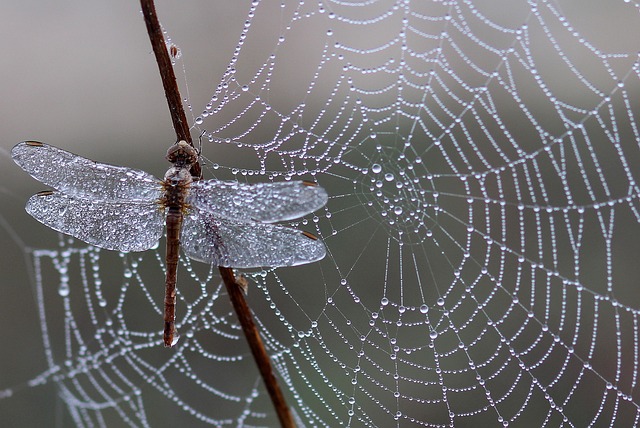Dragonflies have long been associated with various beliefs and superstitions across different cultures. Some view them as symbols of good luck, transformation, and harmony, while others perceive them as omens of danger or impending doom. The interpretation of dragonflies as either good or bad omens can vary depending on cultural, historical, and personal beliefs. In this introduction, we will explore the different perspectives surrounding dragonflies as omens and the reasons behind these interpretations.
Table of Contents
The Symbolic Meaning of Dragonflies in Different Cultures
Dragonflies have long fascinated people with their delicate wings and vibrant colors. These beautiful creatures can be found all over the world, and they hold a special place in the folklore and symbolism of many different cultures. In this article, we will explore the symbolic meaning of dragonflies in various cultures and try to answer the question: are dragonflies a good or bad omen?
In Native American cultures, dragonflies are often seen as a symbol of transformation and change. They are believed to bring messages from the spirit world and are seen as a sign of good luck. The Navajo people, for example, believe that dragonflies are the spirits of their ancestors, guiding them and protecting them from harm. In this context, dragonflies are definitely seen as a positive omen.
In Japanese culture, dragonflies are also seen as a symbol of good luck and prosperity. They are associated with the samurai, who believed that dragonflies represented strength and victory in battle. Dragonflies are often depicted in Japanese art and are considered a sign of good fortune. So, in Japan, dragonflies are definitely seen as a positive omen.
However, not all cultures view dragonflies in such a positive light. In some European folklore, dragonflies are associated with evil spirits and are seen as a bad omen. In Sweden, for example, it is believed that if a dragonfly lands on your head, it is a sign that you will soon die. Similarly, in some parts of England, dragonflies are thought to be the souls of the dead, and seeing one is considered a warning of impending death. So, in these cultures, dragonflies are seen as a bad omen.
In Chinese culture, dragonflies are associated with summer and are seen as a symbol of joy and happiness. They are often depicted in art and literature as a representation of the fleeting nature of life. Dragonflies are also believed to bring good luck and prosperity, especially in matters of love and romance. So, in China, dragonflies are definitely seen as a positive omen.
In conclusion, the symbolic meaning of dragonflies varies greatly across different cultures. While they are generally seen as a positive omen in Native American, Japanese, and Chinese cultures, they are viewed as a bad omen in some European folklore. It is important to remember that these beliefs are deeply rooted in cultural traditions and should be respected as such.
Whether you see dragonflies as a good or bad omen ultimately depends on your own cultural background and personal beliefs. However, it is hard to deny the beauty and grace of these creatures. So, the next time you see a dragonfly fluttering by, take a moment to appreciate its delicate wings and vibrant colors, regardless of whether you see it as a good or bad omen.
Dragonflies as Messengers of Change and Transformation

Dragonflies have long been associated with change and transformation in various cultures around the world. These fascinating creatures, with their delicate wings and vibrant colors, have captured the imagination of many. But are dragonflies really messengers of change and transformation, or is it just a myth?
In many Native American cultures, dragonflies are seen as symbols of change and transformation. They believe that when a dragonfly appears, it is a sign that change is coming. This change could be in the form of a new beginning, a shift in perspective, or a personal transformation. The dragonfly is seen as a guide, leading individuals through the process of change and helping them navigate the unknown.
The idea of dragonflies as messengers of change is not limited to Native American cultures. In Japan, dragonflies are associated with the changing of seasons. They are believed to bring good luck and prosperity, signaling the arrival of warmer weather and the abundance of summer. In Chinese culture, dragonflies are seen as symbols of harmony and prosperity. They are often depicted in art and literature as bringers of good fortune.
But what is it about dragonflies that make them such powerful symbols of change and transformation? One reason could be their life cycle. Dragonflies undergo a remarkable transformation from egg to nymph to adult. This process of metamorphosis is seen as a metaphor for personal growth and transformation. Just as the dragonfly emerges from the water as a beautiful creature with wings, so too can individuals emerge from challenging situations with newfound strength and resilience.
Another reason could be the way dragonflies move. They are known for their agility and speed, darting through the air with grace and precision. This ability to navigate through obstacles and change direction quickly is seen as a lesson for individuals facing change in their own lives. Dragonflies remind us to be adaptable and flexible, to embrace change rather than resist it.
Dragonflies also have a unique way of capturing our attention. Their vibrant colors and intricate patterns make them stand out in their surroundings. When a dragonfly appears, it is hard not to notice it. This ability to capture our attention is seen as a reminder to pay attention to the signs and messages that life is sending our way. Dragonflies encourage us to be present in the moment and to be open to the possibilities that change can bring.
So, are dragonflies a good or bad omen? It ultimately depends on how we choose to interpret their presence. If we see them as messengers of change and transformation, then they can be seen as positive symbols in our lives. They remind us to embrace change, to be adaptable, and to find strength in the face of adversity. However, if we choose to see them as omens of doom or bad luck, then that is the energy we will attract.
In the end, dragonflies are simply creatures of nature, going about their lives in their own unique way. Whether we see them as messengers of change or not, there is no denying their beauty and grace. So, the next time you spot a dragonfly, take a moment to appreciate its presence and the lessons it may have to offer.
The Role of Dragonflies in Ecosystems and Their Environmental Significance
Dragonflies are fascinating creatures that have captured the imagination of humans for centuries. With their shimmering wings and graceful flight, they are often seen as a symbol of beauty and tranquility. However, throughout history, dragonflies have also been associated with various superstitions and beliefs. Some cultures consider them to be a good omen, while others view them as a bad sign. So, are dragonflies really a good or bad omen? To answer this question, we need to understand the role of dragonflies in ecosystems and their environmental significance.
Dragonflies play a crucial role in maintaining the balance of ecosystems. As voracious predators, they feed on a wide range of insects, including mosquitoes, flies, and other pests. This makes them valuable allies in controlling populations of these nuisance insects. In fact, dragonflies are so effective at pest control that some farmers even use them as a natural alternative to chemical pesticides. By keeping insect populations in check, dragonflies help to prevent the spread of diseases and reduce the need for harmful chemicals in our environment.
Not only do dragonflies help to control pests, but they also serve as indicators of environmental health. These delicate creatures are highly sensitive to changes in water quality and habitat conditions. Their presence or absence can provide valuable insights into the overall health of an ecosystem. For example, if dragonfly populations decline in a particular area, it could be a sign of pollution or habitat destruction. Conversely, a thriving dragonfly population indicates a healthy and well-balanced ecosystem.
Dragonflies are also important pollinators. While bees and butterflies often steal the spotlight when it comes to pollination, dragonflies play a significant role in this process as well. As they move from flower to flower in search of prey, they inadvertently transfer pollen, helping to fertilize plants and ensure their reproduction. Without dragonflies, many plant species would struggle to reproduce, leading to a decline in biodiversity.
In addition to their ecological significance, dragonflies have also inspired countless myths and legends. In some cultures, they are believed to bring good luck and prosperity. For example, in Japanese folklore, dragonflies are seen as symbols of courage and strength. They are often associated with samurais and are believed to bring protection and success. Similarly, in Native American cultures, dragonflies are considered to be messengers of joy and transformation.
On the other hand, dragonflies have also been associated with negative beliefs in certain cultures. In European folklore, they were often seen as sinister creatures, associated with witches and dark magic. Some people believed that if a dragonfly landed on you, it was a sign of impending death or misfortune. However, it is important to remember that these superstitions are rooted in ancient beliefs and should not be taken literally in modern times.
In conclusion, dragonflies are not inherently good or bad omens. Instead, they are fascinating creatures that play a vital role in ecosystems and serve as indicators of environmental health. Their ability to control pests, pollinate plants, and thrive in diverse habitats makes them valuable allies in our efforts to protect and preserve the natural world. So, the next time you see a dragonfly, instead of worrying about its symbolism, take a moment to appreciate its beauty and the important role it plays in our environment.
Superstitions and Folklore Surrounding Dragonflies as Omens
Dragonflies have long been a subject of fascination and intrigue. With their delicate wings and vibrant colors, they are often seen as a symbol of beauty and grace. However, in many cultures, dragonflies are also associated with superstitions and folklore, particularly as omens. But are these beliefs rooted in truth, or are they simply products of human imagination?
One common belief surrounding dragonflies is that they bring good luck. In some cultures, it is believed that if a dragonfly lands on you, it is a sign of good fortune and prosperity. This belief may stem from the fact that dragonflies are often found near bodies of water, which are traditionally associated with abundance and wealth. Additionally, the dragonfly’s ability to fly swiftly and gracefully may be seen as a metaphor for success and achievement.
On the other hand, there are also those who view dragonflies as harbingers of bad luck. In certain cultures, it is believed that if a dragonfly enters your home, it is a sign of impending death or illness. This belief may have originated from the fact that dragonflies are often found near stagnant water, which can be a breeding ground for disease-carrying insects. Furthermore, the dragonfly’s association with darkness and the night may have contributed to its negative connotations.
Despite these conflicting beliefs, it is important to remember that superstitions and folklore are often based on cultural traditions and personal experiences rather than scientific evidence. In reality, dragonflies are harmless creatures that play a vital role in maintaining the balance of ecosystems. They are efficient predators, feeding on mosquitoes and other insects, thus helping to control their populations. In this sense, dragonflies can actually be seen as beneficial creatures that contribute to the overall health of the environment.
In some cultures, dragonflies are also seen as spiritual messengers. They are believed to carry messages from the spirit world or serve as a link between the physical and spiritual realms. This belief may have originated from the dragonfly’s ability to move between air and water, symbolizing the connection between different elements of existence. In this context, dragonflies are seen as guides or protectors, offering comfort and guidance to those who believe in their spiritual significance.
Ultimately, whether dragonflies are considered good or bad omens depends on one’s cultural background and personal beliefs. While some may view them as symbols of luck and prosperity, others may see them as signs of impending doom. However, it is important to approach these beliefs with an open mind and a healthy dose of skepticism. Rather than relying solely on superstitions, it is always beneficial to seek a deeper understanding of the natural world and the creatures that inhabit it.
In conclusion, dragonflies have a rich history of superstitions and folklore surrounding them as omens. Whether they are seen as bringers of good luck or harbingers of bad fortune, these beliefs are deeply rooted in cultural traditions and personal experiences. However, it is important to remember that dragonflies are harmless creatures that play a vital role in the ecosystem. Instead of relying solely on superstitions, it is always beneficial to appreciate the beauty and grace of these creatures while also seeking a deeper understanding of their ecological significance.
Conclusion
In conclusion, dragonflies are generally considered to be a positive symbol and are often associated with good luck, transformation, and harmony in many cultures around the world. However, interpretations of omens can vary among different belief systems and individuals.


